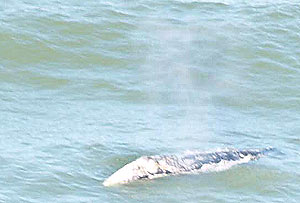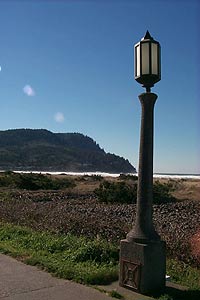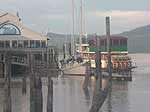 |
Published 08/21/09
Whales an Unusual Sight on North Oregon Coast, Other Oddities
 |
| Whale spouting near Seaside (photo Jaime Oxley, Seaside Aquarium) |
(Seaside, Oregon) - Whales are getting spotted in an unusual place on the Oregon coast – in Seaside, and it's taking state whale officials by surprise. Meanwhile, glowing sand has been making an appearance in recent weeks along the coast as well, making the beaches at night a little more surreal.
Seaside Aquarium and city tourism officials are reporting lots of visitors saying they’re spotting whales not just in the cove area of Seaside but from the Promenade as well. Gray whales, including plenty of calves, have been seen cavorting around the area since July.
Morris Grover, with the Whale Watch Center in Depoe Bay, said that’s a little unusual because whales aren’t known for hanging out in Seaside too often, and given the flat terrain there it’s much harder to see them.
 |
| A baby gray whale photographed by Oxley near Seaside. |
Keith Chandler and Tiffany Boothe of the aquarium say tourists have been talking about it happening fairly frequently. Jaime Oxley of the aquarium even photographed a few, including a baby whale.
Boothe said this happens more often than people think.
“We often get gray whales here in the cove this time of year, but they often stay longer when we are having a good anchovy run, which we are currently having,” said Boothe.
While they may be around frequently, they’re hard to spot because of large waves in the region coupled with the flat landscape.
“They are on their way up to their summer feeding grounds up in the Bering Sea, and just stop here for a snack,” Boothe said.
 |
| Seaside's flat terrain isn't usually conducive to spotting whales. |
Grover said the whales are obviously finding something to munch on, although anchovies are not a regular part of their diet.
He said it’s likely they’re feeding off the sea floor, diving down and taking enormous chunks of mud into their mouths, and then filtering out the phytoplankton.
In rocky places, like Depoe Bay, they feed off the myacids in the water columns. But the dynamics of the ocean are much different in sandy areas like Seaside and food usually only lurks in the muddy bottom.
“They take a pretty large sized chunk out of the ocean floor mud,” Grover said. “They take out a chunk the size of a desk, and about a foot thick.”
Grover said whale watching numbers have been fantastic all summer, having started sooner than usual, but officials are worried they may leave early because of a light El Nino condition that could start cutting off the food supply earlier.
“It means warmer waters, and if there’s less upwelling because of that, the food supply doesn’t come up,” Grover said.
Whale watch officials in northern California have told Grover they’re now shut down because the whales have already left there.
Gray whales aren’t the only ones being seen on the north coast, apparently. To add more oddness to the Seaside whale story, Chandler said a friend of his took a picture of what appears to be a minke whale in the Seaside area, chasing anchovies.
 |
| Glowing phytoplankton as photographed by Boothe in 2007: the two bluish dots are the only ones visible. |
The freaky glowing sand is still being seen as well. BeachConnection.net staff have seen plenty of the glowing critters on Oregon beaches in recent weeks. It’s caused by microscopic phytoplankton that are bioluminescent, which then start glowing or giving off a brief flash when you step on them.
They show up as tiny, often faint, greenish sparks beneath your feet. They are usually found on wet sand, or in pools of water that have been standing around for most of the day.
BeachConnection.net spotted them – albeit extremely faint – in Lincoln City this past week. They were more prominent two weeks ago in Rockaway Beach. There is no way to predict when or where they will show up again, although it's worth a try to hit a dark beach anywhere on the coast at any time between now and early October.
You must find an extremely dark beach with no ambient light interference to see them.
 |
 |
 |
 |
RELATED STORIES
Unusual Travel Articles TravelParanormal.com allows you to submit your own creepy tale or debunk one - or see up-to-the-minute news headlines about travel and the paranormal.
Watching Transformations of Oregon Coast Beaches Seasons change and so do beaches, revealing different sides and a variety of eye-popping sights
Staggeringly Cool Ideas for Oregon Coast Romance Be it the season of Valentine's or be it any time of the year, Oregon's coastline has essentially cornered the market for cuddle-inducing possibilities and gushy activities for the hand-holding set
Day or Night Mysteries and Merriment on Oregon Coast It's more than just nightlife that comes to life, but the beaches offer major opportunities
News Headlines from All Over Oregon Need to scan Oregon headlines? Constantly updated news from all over Oregon: a comprehensive, up-to-the-minute display of news headlines from a variety of media.
Secrets of the Season |




































